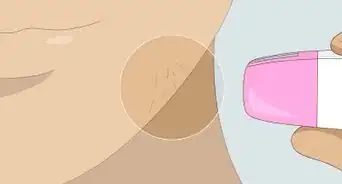This article was co-authored by Adarsh Vijay Mudgil, MD. Dr. Adarsh Vijay Mudgil is a board certified Dermatologist, Dermatopathologist, and the Owner of Mudgil Dermatology, a state-of-the-art dermatology practice based in New York, New York. As one of the few dermatologists in the area to achieve board certification in both dermatology and dermatopathology, Dr. Mudgil specializes in all aspects of medical, surgical, and cosmetic dermatology. He received his Bachelor's degree with Phi Beta Kappa honors from Emory University and earned his Doctor of Medicine (MD) with Alpha Omega Alpha honors from the Stony Brook University School of Medicine. In medical school, Dr. Mudgil was among a handful of students nationwide to receive a coveted Howard Hughes Medical Institute Fellowship and Scholarship. He then completed his residency in dermatology at the Mount Sinai Medical Center in Manhattan, where he served as chief resident. Additionally, Dr. Mudgil went on to complete a fellowship at the prestigious Ackerman Academy of Dermatopathology. He is a fellow of the American Academy of Dermatology, the American Society for Dermatologic Surgery, and the American Society of Dermatopathology. Dr. Mudgil is also a member of the Mount Sinai School of Medicine teaching faculty.
There are 15 references cited in this article, which can be found at the bottom of the page.
wikiHow marks an article as reader-approved once it receives enough positive feedback. This article received 16 testimonials and 84% of readers who voted found it helpful, earning it our reader-approved status.
This article has been viewed 1,863,417 times.
Many women choose to groom their pubic region by removing some or all of their vaginal hair. Whether you’re choosing to prevent ingrown hairs, for cleanliness, or for aesthetic reasons, there are various options to remain safe while doing so. To remove vaginal hair safely at home, try shaving, using hair removal creams, or using cold wax. Or, if you want a professional’s help, consider getting a hot wax or investing in laser hair removal.
Steps
Removing Hair by Shaving
-
1Decide what area you want to shave.[1] You don’t have to shave all of your vaginal hair off. Depending on why you’re shaving, you can shave just the bikini line (aka the part that would be visible if you wore a bikini) or remove all of your hair. Pick and choose how much shaving feels right for you -- for example, you might not want to shave the labia or the hair around the anus. Do what feels comfortable for you!
- If you want, you can even make designs, like a triangle or square of hair!
-
2Trim your hair before shaving. Don’t get too close to the skin, as you could accidentally cut yourself. Use a hand mirror to see well, and stop cutting when you think you’re getting too close to the skin. Your goal is just to trim the hair down if it’s long, not to cut it all the way to the roots.[2]
-
3Take a 5-10 minute warm shower or bath before shaving. Warm water can help soften your skin and relax your hair follicles, leading to an altogether more pleasant experience![3]
-
4Exfoliate gently before shaving to help prevent ingrown hairs. Choose a mild chemical exfoliator like Origins Modern Friction or Nivea Gentle Exfoliating Scrub. Apply the product with small, circular motions and gently scrub for 30 seconds. Rinse with warm water.[4]
- Never exfoliate or shave if you have open cuts, or if your skin is sunburned.
-
5Apply shaving cream or gel. Be careful not to get any shaving cream into your vagina. Only apply cream to the outside of the labia, and reapply when necessary. Use a clear shaving cream or gel so you can see where the hairs are.[5]
- In a pinch, you can also use conditioner, though you shouldn’t get in the habit of doing so because it lacks the moisturizing qualities of most shaving creams.
- Do not use soap or shampoo as replacements for shaving cream.[6]
-
6Use a sharp razor. Consider putting on a new razor head before shaving your vaginal hair. Choose a razor you’re comfortable using, and keep in mind that the larger the razor, the more unwieldy it might be.[7]
- For added ease, consider using a razor with a built-in moisturizing strip. This can help make the shaving session easier and smoother.
-
7Pull the skin taut with one hand. The hard part about shaving genital hair is that your vagina does not offer many smooth, flat surfaces. Create these flat surfaces by gently pulling the skin back until it’s flat with your non-dominant hand, and then shave with your dominant hand.[8]
-
8Shave in the direction of hair growth. Shaving in the direction of hair growth instead of against it helps prevent ingrown hairs. Shave slowly and evenly, without rushing. Rinse your razor regularly to get rid of trapped hair and ensure a smoother shave.[9]
-
9Rinse your skin when finished. Remove all shaving cream and hair from the area. If you accidentally cut yourself while shaving, remove the blood as well, and don’t worry! A little nick is okay. However, seek medical attention if you severely cut yourself.
-
10Apply baby oil or aloe vera to help soothe your skin. Baby oil also helps keep the skin pimple-free, while aloe vera is better for sensitive skin. Apply until the area is coated in a thin layer. Reapply as needed.[10]
- Don’t use aftershave or your regular moisturizing lotion, as these can sting terribly!
Using Removal Cream on Bikini Line Hair
-
1Trim down your hair before applying. Be careful with the scissors and make sure you don’t cut yourself. If you think the scissors are getting too close to your skin, stop cutting the hair.
-
2Test a small bit of cream on your arm before using. Before using any unknown substances or creams, it’s always a good idea to apply the cream to a small, non-sensitive area. Use your arm or thigh to test if the cream causes excessive redness, pain, or some other negative reaction. Don’t use it on your vaginal hair if that happens!
- Wait 24 hours after the test before applying the cream to your pubic area.
-
3Don’t apply the cream to sensitive areas. If the cream didn’t cause a negative reaction, it’s probably safe to use on your vaginal hair. However, take precautions to make sure the cream does not get into your vagina. Use the cream to remove hairs from the exterior of your vagina, and stay well away from your labia.
-
4Apply a thin layer of cream with the package applicator. Apply the cream smoothly and evenly, taking care to avoid any buildup areas. Follow all package instructions, and wash your hands after use. Remember to never apply the cream to sensitive areas! Stick to the bikini line for optimal effects.
- If any cream gets inside your labia, rinse immediately.
-
5Wait the recommended amount. There are different waiting times depending on what hair removal cream you’ve used. Set an alarm and prepare to remove the hair removal cream once the appropriate amount of time has passed.
-
6Rinse in the shower. Turn on the shower and gently rinse all of the hair removal cream away. Use a towel or washcloth to remove the cream. Your hairs should fall off with the cream. If they don’t, wait 24 hours and then try again.
Applying Cold Wax
-
1Buy an at-home waxing kit. You can purchase an at-home waxing kit online or in your neighborhood pharmacy supermarket. You can buy a one-time waxing kit or a package with multiple waxing sets. Note that different types of waxing kits are tailored to different areas of the body, so make sure you buy the waxing kit for vaginal hair.
- One-time at-home waxing kits range from $5-$15 per kit.
-
2Trim your hairs so that they are .25 inches (0.64 cm) long. If your hair is too long, you might have a hard time pulling it off, or you might feel pain from pulling hairs in different directions. If your hair is too short, your waxing strips won’t have much to grip onto, and you might not be able to wax successfully.
- You only need to trim the hair you want to wax. Decide if you want a full wax or a bikini line wax.
-
3Prevent ingrown hairs and reduce pain by exfoliating before waxing. Use a body scrub or exfoliating glove to remove the layer of dead skin cells at the top of your skin before waxing.
-
4Warm the cold wax strips between your hands before applying. Gently rub your hands over the cold wax strips to heat them up slightly with your body heat. This will help them stick better to your hair. Don’t heat them up in a microwave or hot water -- your body heat is enough to get them hot.
-
5Apply baby powder to your skin. Baby powder helps absorb any moisture on your skin, and ensures the wax strip will go on smoothly.
-
6Pull the skin taut. This is especially important for wax since you’ll be pulling against the skin. Use your nondominant hand to stretch the skin as taut as possible. You should feel a slight discomfort, but no serious pain. Ease up if it feels extremely painful.
-
7Apply the waxing strip in the direction of hair growth and press down. Make sure the waxing strip is firmly pressed onto your skin. Rub it in slightly to ensure all edges are in place.[12]
-
8Pull quickly. Don’t be afraid of pain -- waxing does hurt, but pulling the strip off slowly will only lead to an inefficient waxing experience, and you’ll have to try again. Worse, pulling slowly can make waxing more painful. Imagine you’re ripping off a bandaid, and pull all at once.[13]
- Try breathing exhaling deeply right as you pull to distract yourself from the pain.[14]
-
9Soothe skin with baby oil or aloe vera. If you have sensitive skin, aloe vera can be very soothing after a cold wax session. Apply a thin layer and reapply as needed. Never use aftershave or regular moisturizer, as this can be extremely painful and dry out your skin.[15]
Getting Professionally Waxed
-
1Don’t shave for three weeks before waxing. If you regularly shave, and are transitioning into professional waxing, don’t shave for three weeks so your hair can grow out. If you have never removed your vaginal hair, consider trimming it. The ideal length of hair for waxing is about .25 inches (0.64 cm).[16]
-
2Decide what type of wax you want. There are two types of waxes: the bikini (which removes hair from the top and sides of your vagina) and the Brazilian (which removes everything). Decide how much hair you want to remove, and choose the wax that’s right for you.
- If you’re a beginner, don’t start with the Brazilian, as it can be painful. Instead, ease your way in by getting a few bikini waxes done first.
-
3Find a salon you trust. Look for nail and spa salons in your area. One easy way to find places that wax is to call all of the nail salons in your area and ask if any of them do waxing. Ask about their practice, how they ensure that everything is sterile and clean, and how much the wax will cost.
- Depending on where you live, a professional waxing session can range from $35-$80.[17]
-
4Take a painkiller or anti-inflammatory drug before your session. Waxing is not a pain-free process, though it is a manageable one. Take one regular dose of your preferred painkiller to prepare for your session. If you have a low pain tolerance, bring another painkiller for after the session. Do not take more than one standard dose before your wax.
-
5Don’t worry about feeling awkward during your session. If it’s your first time getting professionally waxed, you might be uncomfortable or even nervous about being naked from the waist down in front of a stranger -- but you have nothing to worry about! Your waxing technician is a professional.
- If you still feel uncomfortable after a few sessions, try listening to music or an audiobook while you get waxed. This can help keep your mind off the situation.
- If your waxing technician ever makes you feel uncomfortable or does something inappropriate, leave the session as soon as you can and report them to a manager or the police.
-
6Exhale as the waxing strip is pulled. While nowhere near unmanageable, waxing will probably cause you some pain. Try not to clench your teeth or muscles against it, because that’ll only make the experience worse. Instead, focus on breathing deeply and exhale right as the strip is being pulled.[18]
- Getting waxed right after your period is said to help with the pain!
-
7Wear comfortable underwear and a skirt or loose-flowing pants. You’re going to be tender and your skin will be sensitive after your waxing session. Prepare for that tenderness by wearing comfortable cotton underwear and a skirt or other comfortable pants.[19]
- Avoid wearing tight pants or underwear for at least a day after waxing.
-
8Exfoliate a week after your session. To keep your vaginal area smooth and prevent irritation or ingrown hair, exfoliate gently one week after your session with a loofah.[20]
Investing in Laser Hair Removal
-
1Don’t plan on laser hair removal if you have light hair or dark skin. Laser hair removal works best on light skin with dark hair. If your hair is too light, the laser won’t be able to find your hair follicles (which is how the laser works). If your skin is too dark, the laser might confuse your skin for hair follicles, which could hurt or even permanently burn you.[21]
- New lasers, like the Nd:YAG, work better with darker skin types, but make sure you call your local laser hair removal location and confirm they have the Nd:YAG laser.
-
2Budget for laser hair removal. The average price for a laser hair removal depends on whether you want a bikini or Brazilian laser hair removal. The average price of a bikini laser hair removal session in the US is $150, but it can be as high as $450. The average price of a Brazilian laser hair removal session in the US is $250, but it can be as high as $500.
-
3Do not wax for at least 4 weeks before your laser hair removal.[22] Laser hair removal requires that hair follicles be intact and inside your skin, and waxing removes hair follicles. Make your laser hair removal most successful by refraining from waxing for at least one month prior to your removal.
-
4Shave (don’t use cream) before your treatment. In order to get the most out of your laser hair removal experience, you need to shave all of your vaginal hair the night before.[23] Avoid using hair removal creams to remove hair before laser hair removal, as the chemicals can interact and cause irritation or pain.[24]
-
5Let go of any awkward feelings. You might feel nervous or even mildly wary about being naked from the waist down in front of another person, but don’t worry! Your laser hair removal technician is a professional. If you need to distract yourself from the awkwardness, focus on the sound the laser is making.
- If your laser hair removal technician ever does or says anything inappropriate, end the session as soon as you can and report them to a manager or the police.
-
6Tell your technician if you feel intense pain. Laser hair removal generally feels like slight, mildly uncomfortable prickling. If you feel any pain or intense heat, ask your technician to turn down the intensity. Don’t worry about “not getting your money’s worth” -- if you feel prickling, it’s working!
-
7Don’t be surprised when your hair falls out. Laser hair removal isn’t immediately visible. It takes about 2 weeks before the removal starts showing effects, and until that point, your hair will be growing normally. After 2-3 weeks, your hair will start falling out. At this point, it’s ok to shave.[25]
-
8Prepare for multiple treatments. Laser hair removal can require anywhere from 1 to 10 treatments to fully and permanently remove hair. The average treatment length is 6 treatments.
- Do not wax or pluck your hair in-between sessions. Shaving is okay.[26]
Expert Q&A
Did you know you can get expert answers for this article?
Unlock expert answers by supporting wikiHow
-
QuestionHow do I prepare for vaginal hair removal?
 Adarsh Vijay Mudgil, MDDr. Adarsh Vijay Mudgil is a board certified Dermatologist, Dermatopathologist, and the Owner of Mudgil Dermatology, a state-of-the-art dermatology practice based in New York, New York. As one of the few dermatologists in the area to achieve board certification in both dermatology and dermatopathology, Dr. Mudgil specializes in all aspects of medical, surgical, and cosmetic dermatology. He received his Bachelor's degree with Phi Beta Kappa honors from Emory University and earned his Doctor of Medicine (MD) with Alpha Omega Alpha honors from the Stony Brook University School of Medicine. In medical school, Dr. Mudgil was among a handful of students nationwide to receive a coveted Howard Hughes Medical Institute Fellowship and Scholarship. He then completed his residency in dermatology at the Mount Sinai Medical Center in Manhattan, where he served as chief resident. Additionally, Dr. Mudgil went on to complete a fellowship at the prestigious Ackerman Academy of Dermatopathology. He is a fellow of the American Academy of Dermatology, the American Society for Dermatologic Surgery, and the American Society of Dermatopathology. Dr. Mudgil is also a member of the Mount Sinai School of Medicine teaching faculty.
Adarsh Vijay Mudgil, MDDr. Adarsh Vijay Mudgil is a board certified Dermatologist, Dermatopathologist, and the Owner of Mudgil Dermatology, a state-of-the-art dermatology practice based in New York, New York. As one of the few dermatologists in the area to achieve board certification in both dermatology and dermatopathology, Dr. Mudgil specializes in all aspects of medical, surgical, and cosmetic dermatology. He received his Bachelor's degree with Phi Beta Kappa honors from Emory University and earned his Doctor of Medicine (MD) with Alpha Omega Alpha honors from the Stony Brook University School of Medicine. In medical school, Dr. Mudgil was among a handful of students nationwide to receive a coveted Howard Hughes Medical Institute Fellowship and Scholarship. He then completed his residency in dermatology at the Mount Sinai Medical Center in Manhattan, where he served as chief resident. Additionally, Dr. Mudgil went on to complete a fellowship at the prestigious Ackerman Academy of Dermatopathology. He is a fellow of the American Academy of Dermatology, the American Society for Dermatologic Surgery, and the American Society of Dermatopathology. Dr. Mudgil is also a member of the Mount Sinai School of Medicine teaching faculty.
Board Certified Dermatologist & Dermatopathologist
Warnings
- Be very cautious of shaving or waxing your pubic area while you’re on your period, as it can become very sensitive.⧼thumbs_response⧽
- Always use clean materials to avoid getting a disease. Don’t use any metal that is old or rusted as this could injure you.⧼thumbs_response⧽
References
- ↑ Adarsh Vijay Mudgil, MD. Board Certified Dermatologist & Dermatopathologist. Expert Interview. 8 October 2020.
- ↑ http://youngwomenshealth.org/2013/08/22/removing-pubic-hair/
- ↑ https://www.liveabout.com/how-to-shave-your-pubic-hair-area-for-women-1717028
- ↑ https://www.aad.org/public/skin-hair-nails/skin-care/exfoliation
- ↑ https://www.liveabout.com/how-to-shave-your-pubic-hair-area-for-women-1717028
- ↑ http://www.pamf.org/teen/health/skin/pubichairremoval.html
- ↑ http://youngwomenshealth.org/2013/08/22/removing-pubic-hair/
- ↑ http://youngwomenshealth.org/2013/08/22/removing-pubic-hair/
- ↑ http://youngwomenshealth.org/2013/08/22/removing-pubic-hair/
- ↑ http://www.pamf.org/teen/health/skin/pubichairremoval.html
- ↑ http://www.naircare.com/en/Women/Products/Nair-Shower-Power-Sensitive
- ↑ https://www.liveabout.com/when-i-wax-the-hair-doesnt-come-off-1717140
- ↑ https://www.liveabout.com/when-i-wax-the-hair-doesnt-come-off-1717140
- ↑ http://stylecaster.com/beauty/brazilian-wax/
- ↑ http://www.pamf.org/teen/health/skin/pubichairremoval.html
- ↑ http://www.cosmopolitan.com/style-beauty/news/a40350/everything-you-need-to-know-before-getting-a-brazilian-wax/
- ↑ http://stylecaster.com/beauty/hair-removal-101/
- ↑ http://stylecaster.com/beauty/brazilian-wax/
- ↑ http://www.teenvogue.com/story/first-brailizan-wax-tips-facts-advice
- ↑ http://www.teenvogue.com/story/first-brailizan-wax-tips-facts-advice
- ↑ https://www.self.com/story/the-pros-cons-of-laser-hair-re
- ↑ Adarsh Vijay Mudgil, MD. Board Certified Dermatologist & Dermatopathologist. Expert Interview. 8 October 2020.
- ↑ Adarsh Vijay Mudgil, MD. Board Certified Dermatologist & Dermatopathologist. Expert Interview. 8 October 2020.
- ↑ http://www.vogue.com/article/laser-hair-removal-is-it-worth-it
- ↑ https://www.self.com/story/laser-hair-removal-vs-waxing
- ↑ Adarsh Vijay Mudgil, MD. Board Certified Dermatologist & Dermatopathologist. Expert Interview. 8 October 2020.
About This Article
To remove your vaginal hair by shaving, first decide if you just want to shave your bikini line or remove all of your hair. Once you know how much you plan to take off, trim your hair down if it’s long and take a 5 to 10 minute warm shower to soften your skin and relax your hair follicles. In order to prevent ingrown hairs, gently exfoliate your skin. After rinsing with warm water, apply shaving cream or gel, pull your skin taut with 1 hand, and shave in the direction of the hair growth. When you’re done, apply baby oil or aloe vera to help soothe your skin. To learn how to prepare to get your vaginal hair professionally waxed, keep reading!


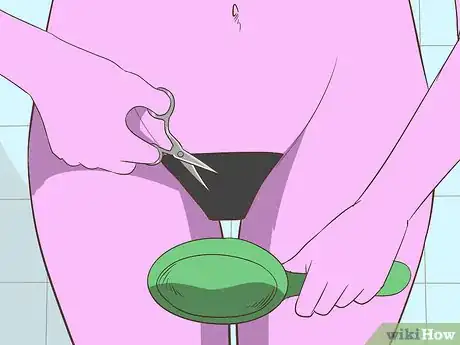
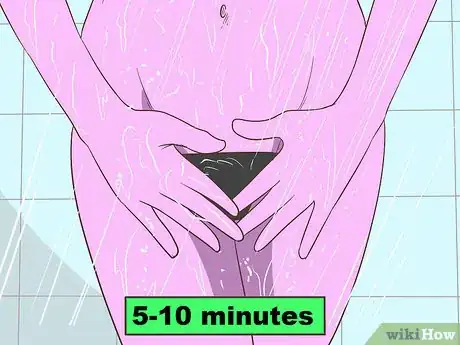
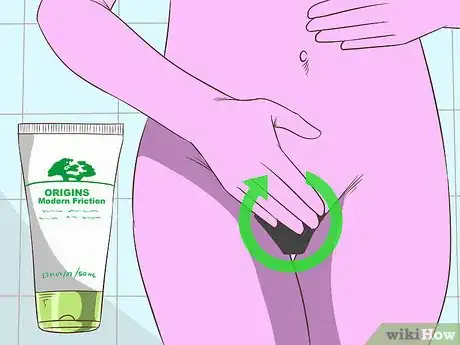




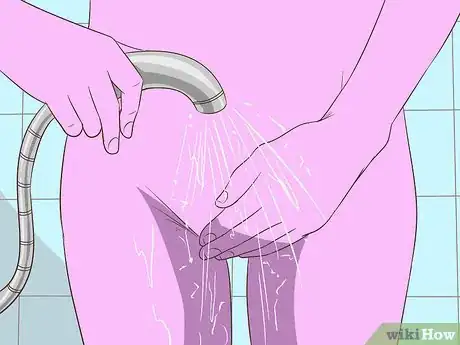
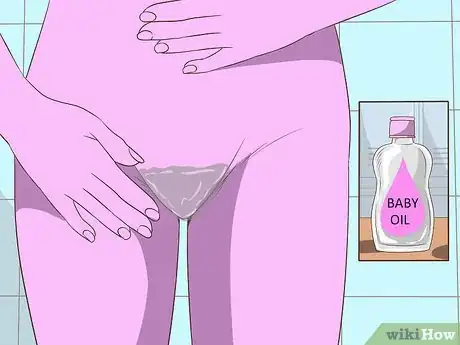
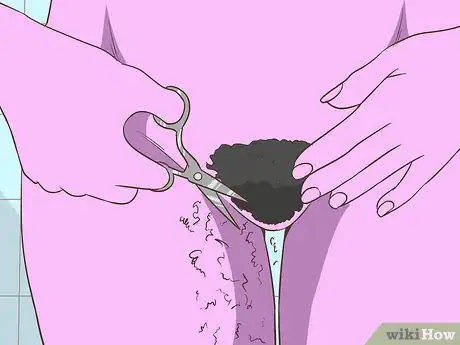






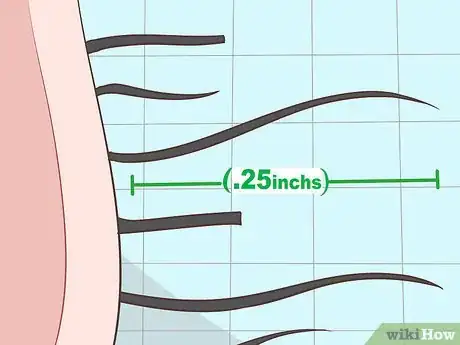


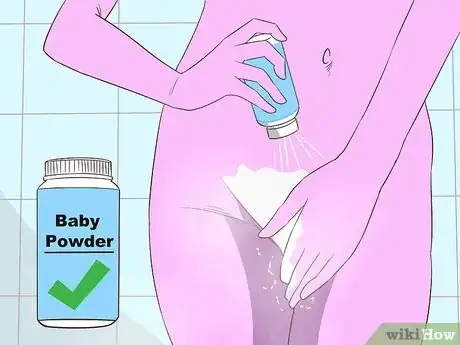



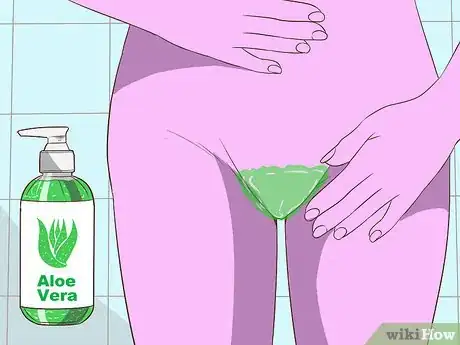






















-Step-24-Version-2.webp)



